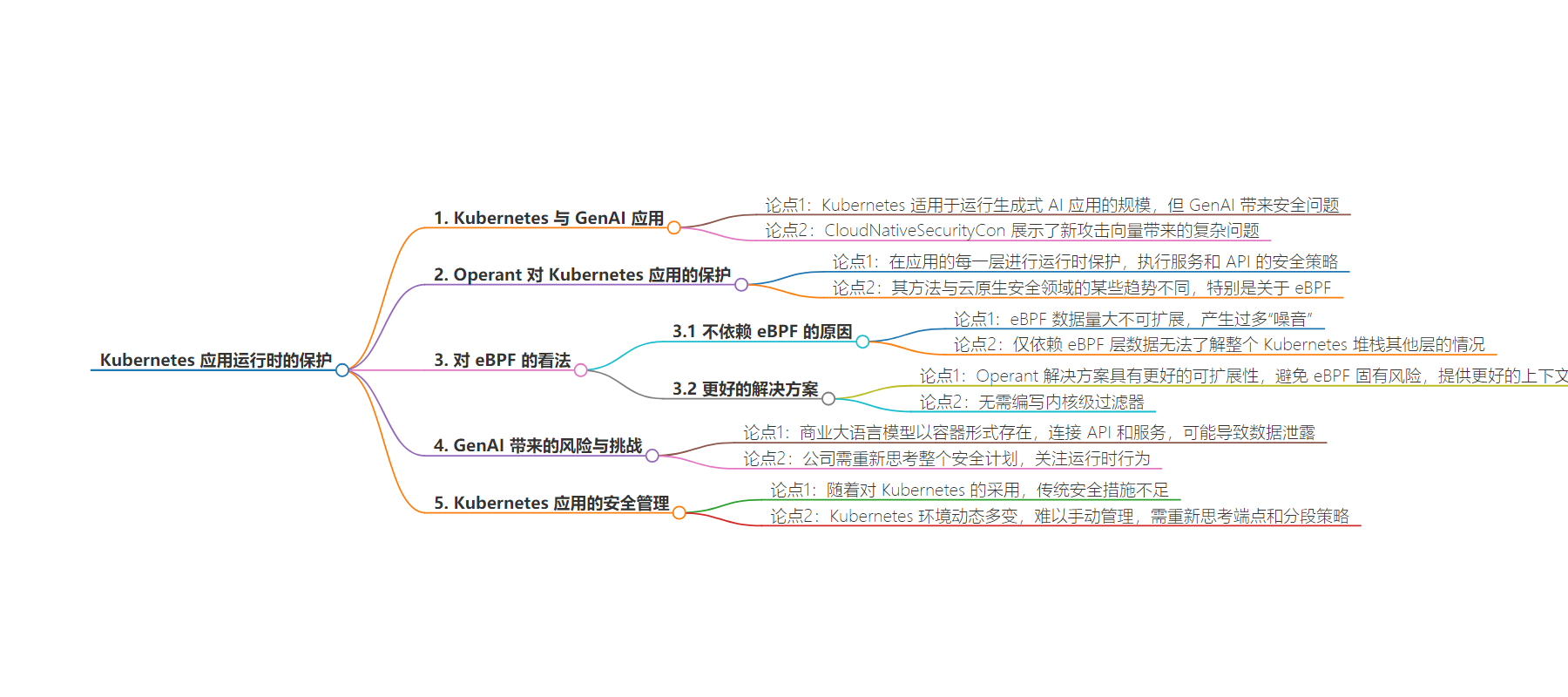包阅导读总结
1.
“`
Kubernetes、GenAI、Operant、eBPF、Runtime Security
“`
2.
Operant 为解决 Kubernetes 应用运行时的安全问题提供新方法,其不依赖 eBPF,认为 eBPF 数据量大且有噪音。随着 GenAI 和 Kubernetes 的发展,安全保护需新思维,不能仅靠传统手段。
3.
– Kubernetes 与 GenAI 的安全挑战
– Kubernetes 适合运行 GenAI 应用,但带来安全问题。
– 新攻击向量使问题更复杂。
– Operant 的解决方案
– 保护 Kubernetes 应用在运行时的各层。
– 不依赖 eBPF,认为其数据量大且噪音多。
– 能减少噪音,提供独特运行时洞察。
– eBPF 的局限性
– 数据过多,不可扩展。
– 依赖内核层数据,缺乏对其他层的理解。
– 现有解决方案需写过滤器,较复杂。
– 新的安全需求
– 考虑更多层的活动和行为。
– 关注运行时行为,应对数据泄漏风险。
– 重新思考安全策略,适应 Kubernetes 的动态性。
思维导图:
文章地址:https://thenewstack.io/bypassing-ebpf-to-protect-runtimes-in-kubernetes-apps/
文章来源:thenewstack.io
作者:Alex Williams
发布时间:2024/8/2 20:19
语言:英文
总字数:909字
预计阅读时间:4分钟
评分:86分
标签:Kubernetes,Kubernetes 安全,运行时保护,eBPF,云原生安全
以下为原文内容
本内容来源于用户推荐转载,旨在分享知识与观点,如有侵权请联系删除 联系邮箱 media@ilingban.com
SEATTLE — Kubernetes is a good fit for the scale needed to run generative AI applications. But GenAI poses a security problem that requires new approaches to protecting runtimes in Kubernetes applications.
If anything, CloudNativeSecurityCon earlier this summer showed how deeply complex the problems become with new attack vectors that compound with GenAI.
One novel new approach to the problem comes from Operant, a runtime application platform provider co-founded by a team of veterans from Apple, Arm, Google, Juniper, Transposit and VMware.
Operant protects Kubernetes applications in runtime at every layer of the application. It enforces security policies for services and APIs, everything within a Kubernetes cluster, said Ashley Roof, co-founder and CMO at Operant.
Roof said customers install Operant and then see a blueprint of their Kubernetes application across all the network layers. Operant’s approach bucks some trends in the cloud native security space, particularly regarding the Extended Berkeley Packet Filter, or eBPF, a Cloud Native Computing Foundation technology.
“We do have an eBPF component that does process-level stuff, but a lot of what we’re doing is not related to that,” Roof said. “And so what that allows us to do is reduce a lot of the noise and have unique runtime insights, which then we are able to prioritize and give people a really strong sense of criticality.”
Operant CEO Vrajesh Bhavsar said his company wants to support users who want to use eBPF. But he sees better approaches than filtering the data firehose from eBPF’s observability of the Linux kernel.
eBPF is a powerful technology that several vendors have tried to productize in many different ways, he said. Operant built a solution that does not rely on eBPF, which the company believes gives its solution better scalability, avoids inherent risks associated with eBPF, and allows for better contextuality.
Too Much Data, Too Much “Noise”
eBPF is not scalable because there is too much data, according to Bhavsar. It’s like tapping the floodgates; eBPF runs all the system data from the kernel.
“Just think of all the ephemeral services that come up for a few minutes and then disappear,” Bhavsar said. “When you have a lot of signals just coming from eBPF sensors, you are then heavily dependent on what’s happening at that layer, without having any understanding of what’s happening in all these other layers across the entire Kubernetes stack. And especially in Kubernetes, this is an especially hard and important problem to solve.”
With Kubernetes, he said, you need to think about more than process-level activities. You also want to look at the behavior of your other pods, containers and services. How are they talking across different networks? What about ingress and egress? How are the APIs talking to each other internally and externally?
“And that’s the approach that we are bringing to market, where teams don’t have to sift through this noise that is coming out of eBPF,” Bhavsar said.
But what about all the other layers? How do you find the needles in this giant haystack of data?
It doesn’t make sense to take the firehose of data and ship it somewhere to analyze, Bhavsar said. How do you make sense of what’s going on in the system at the OS and kernel levels? And how do you make sense of what’s happening at all the other layers?
Many of the existing eBPF solutions require writing filters, he said. But that’s not Operant’s approach: “I’m a kernel engineer. I don’t want to write kernel-level filters, and I don’t want customers to write this.”
Bhavsar worked on iOS and macOS at Apple, building data protection systems, dynamic tracing and the company’s secure enclave technology. His background has allowed him to combine security and machine learning and recognize why generative AI poses such a massive risk, requiring a contextual approach focusing on runtime behavior.
Commercial large language models in all varieties are available on sites like Hugging Face. All these models get delivered as containers. These containers connect to APIs and services. Container portability with generative AI is a potent combination that can lead to data leaks. Companies adopting AI now have to rethink their entire security program. It goes beyond code scanning, identity management or getting the configurations right.
It’s more about what is happening at runtime, Bhavsar said. What is the application doing?
“What are these containers doing when talking to each other?” Bhavsar said. “What data payload is moving across all these different systems? What is going on outside of my environment through these AI APIs? And where are these new kinds of risks and attacks?
As the World Adopts Kubernetes
Everyone is moving towards Kubernetes, especially with GenAI, and adopting models and references.
“We want the world to be ready to secure these environments,” Bhavsar said. But, he added, “a web application firewall or an API gateway is not enough anymore.”
All these applications have deep roots and dependencies that bypass the perimeter, accessing personal, private information such as credit card data.
It’s like a whole new black hole, Bhavsar said, and you can’t manage it manually. There is too much dynamism and ephemerality.
In the old world, you could manually create IP-based rule sets. In Kubernetes, there is no IP address. So engineers must rethink what kind of endpoints to make and what segmentation policies to establish.
YOUTUBE.COM/THENEWSTACK
Tech moves fast, don’t miss an episode. Subscribe to our YouTubechannel to stream all our podcasts, interviews, demos, and more.
